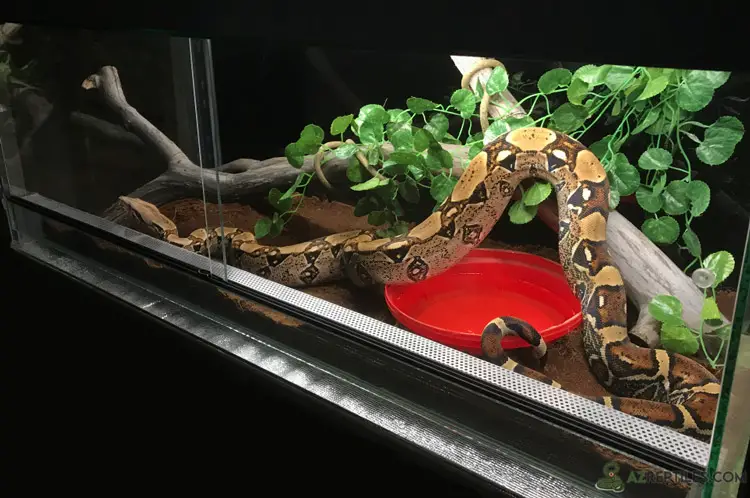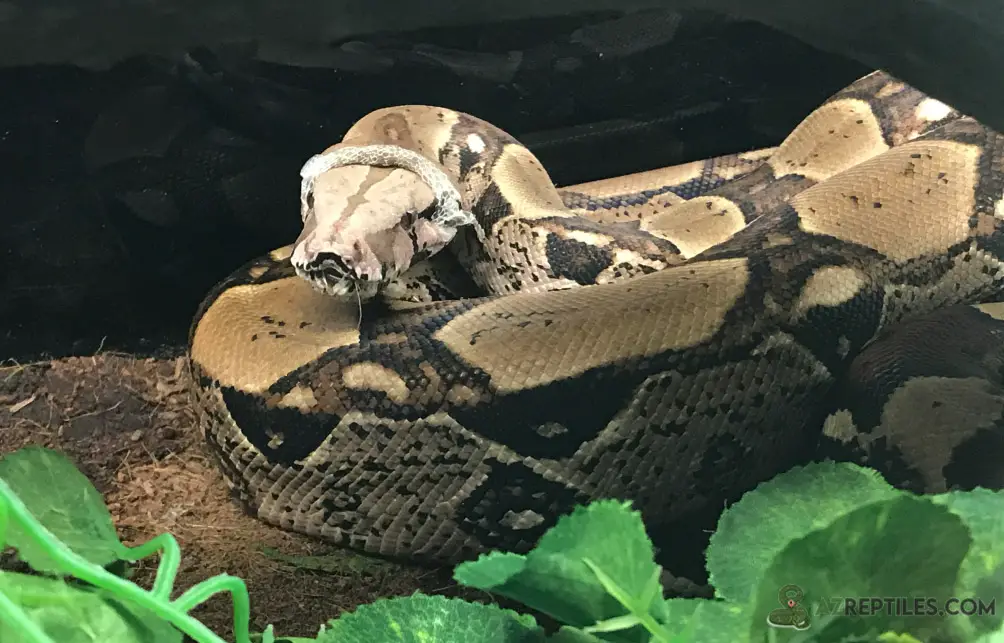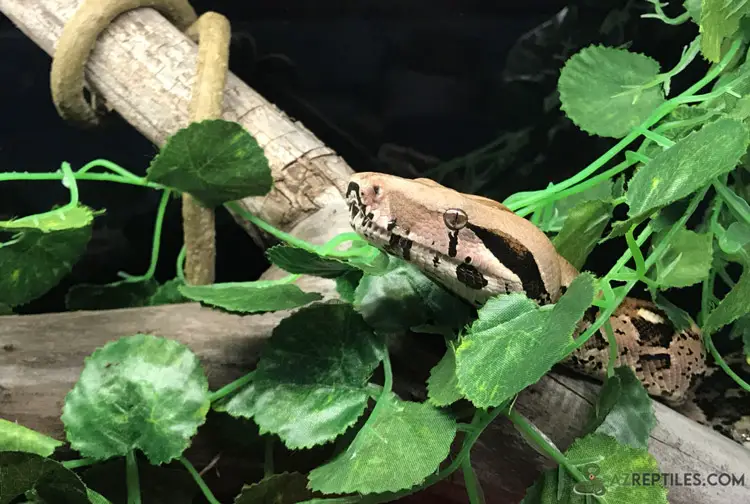Known as one of the largest species of constrictors, the Colombian red tail boa (Boa imperator) is a force to be reckoned with.
Colombian red tail boas are best kept by seasoned snake keepers, as they can reach a very substantial size that can be overwhelming for new keepers. These robust snakes are not only large, but they’re also thick in width and packed with muscle.
The question on our minds today, in regard to this wondrous reptile, is whether it’s a good option for you.
We’re going to go over basic Colombian red tail boa care including feeding, habitat, temperature requirements, and handling. We’ll also cover their medical needs and issues to watch for.
| Common Name: | Colombian Red Tail Boa |
| Scientific Name: | Boa imperator or Boa constrictor imperator (in common usage) |
| Natural Habitat: | Central America and northwestern Colombia |
| Adult Size: | 6 to 9 ft |
| Lifespan: | 20 to 40 years |
| Diet: | Small mammals/rodents/reptiles |
| Experience Level: | Intermediate |
| Enclosure Size: | 6 x 2 x 2 |
Overview
Colombian red tail boas are large, full-bodied, non-venomous constrictors that are native to the Americas. They can be found in Central America and northwestern Colombia.
The common names for this snake are common boa, Colombian boa and northern boa. However, you may also hear these snakes, especially in pet trade, referred to as Colombian red tail boa (or Columbian red tail boa).
Colombian red tails are known for their adult lengths and generous girth. They require moderate to high humidity levels and large enclosures with plenty of enrichment in the way of things to climb and places to hide.
Like most snakes, red tails are carnivores and do well with a diet that consists of mice, rats, rabbits, and other mammals of the appropriate size for each of their life stages.

Colombian Red Tail Boa Enclosure
Size
When it comes to the correct sized enclosure for an adult Colombian red tail boa, there’s much debate. However, most snake keepers agree that whatever size enclosure you choose, your boa should be able to stretch out along two sides.
An enclosure that is 6 x 2 x 2 is ideal, as Colombian red tail boas can stretch out easily along two sides. Sub-adult and juvenile boa imperators can be kept successfully in smaller enclosures, such as extra-large tote bins that have been modified, and commercial enclosures.
REPTI ZOO Large Glass Reptile Terrarium
20-gallon tanks work just fine for young Colombian red tails, but by the time they turn 6 years old, they will need to be upgraded to a 6 x 2 x 2. A good rule of thumb is to have your boa imperator transferred into its adult enclosure by the time it reaches four feet in length.
It can be hard to find enclosures this large, so it’s a good idea to find a source for your enclosure before purchasing a snake that requires this size of the enclosure. In many cases, it’s necessary to purchase a custom-made enclosure.
Humidity
Colombian red tailed boas are found across South and Central America, which means that their natural habitat is one with naturally high humidity levels. Inside your pet Boa imperator’s enclosure, the humidity should be between 60 and 80 percent.
You can achieve this level by positioning a large water bowl underneath a heat bulb or heat emitter. If your enclosure has a mesh lid, you may lose valuable humidity. In this case, cover part of your lid with pegboard, plastic, or another insulating material to help retain humidity. Whatever you choose to use, though, be sure that it has plenty of ventilation holes.
Certain types of bedding can help maintain this level of humidity, too. For example, a bark-based jungle bedding will retain moisture, while aspen shavings dry far too quickly to affect the humidity within the air.
If you’re battling humidity and your boa is small enough to be kept in a plastic tote, we’d recommend keeping them there — totes with lids are much easier to keep humid than a screen-lidded terrarium is.
Temperature
Snakes are cold-blooded and require their enclosure to have a temperature gradient. In other words, one side of the tank should be relatively warm while the other should be cool. There should be a middle ground in between the two extremes.
The cold side and the ambient temperature (general temperature) should rest somewhere between 80 and 85 degrees, while the hot side should be 95 to 100 degrees. To ensure that one side is hotter than the other, you can use a ceramic heat emitter or heat panels, placing them on one side of the enclosure.
VIVOSUN Reptile Heat Mat with Digital Thermostat
If your enclosure is particularly large or made of glass or wood, you may need more than one heat source on the hot side to have that area reach the appropriate temperature.
The closer your snake goes to the heat source, the warmer it will be and vice versa.
Zoo Med Labs Digital Hygrometer and Thermometer
If you find that your snake is too cold, you could consider covering the cold half of the enclosure with a blanket or other insulation to help retain heat. Just be sure that you don’t throw a blanket over the top of a heat lamp or heat panel unless you’re looking to cause a fire.
You can monitor both sides of your enclosures’ temperatures by installing thermometers on both sides or by using a temperature gun and checking periodically.
Lighting
Colombian red tails don’t require any specialized lighting, which sets them (and most other snakes) apart from other reptiles like bearded dragons and most species of lizards.
In most cases, as long as your snake’s enclosure is kept in a room that receives natural sunlight from a window, your boa will be happy. The natural rising and setting of the sun should be adequate for keeping their day/night cycle in its natural rhythm.
Some snake keepers choose to use red or purple bulbs for nighttime viewing. The thought behind this is that snakes can’t perceive the colors of the bulbs, therefore, they don’t affect the day/night cycle.
However, there are mixed opinions on the use of these bulbs, because it’s unclear whether or not the colors of the bulbs can be perceived by reptiles. To ensure that your snake’s cycle isn’t impacted, we’d recommend avoiding these bulbs.
Enrichment
Colombian red tail boas benefit from living in an environment that offers them plenty of stimulation and things to do. That being said, don’t be afraid to fill your boa’s enclosure with accessories — just make sure they’re the right kind.
Hides
Hides are cave-like structures or objects that can be aced in your snake’s enclosure. They can go inside of them to snooze, hide, or prepare to ambush their dinner.
Every enclosure should have at least two hides— one on the hot side and one on the cold side. Your hides should be large enough that your boa fits snuggly inside.
You can provide your snake with a variety of different kinds of hides:
- Commercial caves made for reptiles
- Hollow logs
- Cork rounds
- Plastic storage tubs with an entrance cut out
- PVC pipes
As your snake reaches its full adult size, it gets harder to provide hides of the appropriate size. At some point, you’ll likely have to brush up on your DIY skills and start to consider using storage tubs, cat litter boxes, and other tub-like objects as hides — even if they don’t look as good in your enclosure as a commercial cave might.
Branches/Vines
Some would argue that boas are strictly terrestrial and, therefore, don’t need climbing surfaces. But young boas can be seen using vines and branches to climb and what’s the harm in providing climbing objects even if they aren’t used? They add appeal to the enclosure and can help your boa feel safe and at home.
Finn’s Forest Manzanita Driftwood
Again, depending on your boa’s size, you may be able to find suitable climbing objects at the pet shop. You can usually find relatively small, thin, bendy vines that are made of flexible metal and a bark-like outer coating.
These are suitable for younger boas who aren’t as heavy, but as your boa grows, it’ll need more sturdy and substantial climbing surfaces.
That’s when you can get crafty.
You could use branches that you’ve sourced from outside. Look for branches and logs of suitable size on the ground outside, then take them home and prepare them.
If they’re small enough, bake or freeze them to kill any parasites. If not, let them dry out for weeks to months before use.
You can cut, saw, chop, sand, and otherwise change their appearance as you see fit for your enclosure and needs.
When your boa reaches its maximum weight, it might be necessary to add screws to your branches and logs and secure them to your enclosure to prevent injury.

Plants and Foliage
Boas appreciate a heavily planted terrarium. When choosing foliage for your enclosure, you need to decide whether you want to use live or artificial plants.
Both have their benefits, so do some research to decide which is best for you. But in a nutshell, live plants are beneficial for humidity levels and oxygen but are easily squashed by large snakes and can be hard to keep alive, while artificial plants are more durable and easier to maintain but don’t aid with humidity or look as natural.
If you opt for live plants, here are a few great options that do well in Colombian red tail boa enclosures:
- Pathos
- Ficus
- Rubber plant
- ZZ plant
- Fittonia
- Weeping fig
All live plants should be non-toxic to reptiles and free of pesticides.
Artificial plants offer a lot of versatility in terms of appearance. Just be sure that when you’re choosing your plants that they aren’t sharp or have exposed wires, as your snake’s skin can easily be damaged by sharp edges and protrusions.
Additional
Sphagnum moss and dead leaves, which are also known as leaf litter, make great, all-natural additions to your terrarium.
Galápagos Terrarium Sphagnum Moss
You can buy both in store or, in the case of leaves, take advantage of the fall season, during which you can collect leaves from the ground outside.
Snakes are fond of the new smells and textures that hand-collected leaves provide and many will even burrow.
Diet
Colombian red tail boas eat an assortment of mice, rats, and other prey items. Boa imperators start out on mice and then move on to rats, gerbils, hamsters, chicks, and potentially even rabbits and guinea pigs as they get larger. The size of the prey item depends on the girth of the snake’s body.
Boas should not be fed anything that’s larger than the thickest part of its body. An appropriately sized prey item should leave a noticeable lump in the snake, but the lump should disappear within 24 to 48 hours.
Most keepers feed young snakes once a week, tapering off to once or twice a month as the snake gets older and begins eating larger prey.
Some keepers, though, feed their adult boas once per week — usually slightly smaller prey items, to not overfeed the snake.
Overfeeding can and does happen. If your snake hasn’t had time to fully digest its previous prey item before you give it another, chances are that you’re overfeeding.
It’s generally recommended to feed captive snakes frozen thawed prey (FT) as opposed to live prey. This is, of course, a matter of preference but it’s important to remember the risks of feeding live prey, which include your snake being injured by the live rat or mouse.
Size
Adults range from six to ten feet in length and can way up to 30 pounds. Males are usually smaller than females, so it’s safe to say that any 10-foot Colombian red tails you may see are probably female.
Size, however, can be affected by the snake’s individual diet, too. Snakes that are fed more often will be bigger than those that are fed less — especially while they are still growing.
Lifespan
Boa constrictors are potentially long-lived, perhaps averaging around 20 years old. Captive boas tend to live longer than wild ones, sometimes by as much as 10 to 15 years.
Behavior/Temperament
While temperament varies between each individual snake, the general consensus is that Colombian red tail boas are docile and make great pets.
For the most part, they are slow to strike and very calm when being handled, so long as they have been socialized and are used to being held.
Reproduction
Boas give birth to live young. These tiny babies are only 18 to 24 inches long when they’re first born, and most of their growth occurs before they reach 6 years of age. Each female births 10 to 64 young, with 25 being the average.
Their length increases 3 to 5 times before this age, giving them multiple very noticeable growth spurts.
Male boas are polygynous, which means that each one will mate with as many females as possible. Females can have more than one mate in a season, too, but not near as many as males.
Every given mating season, roughly half of female boas mate and give birth. In addition, only the healthy boas that are in good physical condition will mate. This is to ensure that they are healthy enough to withstand pregnancy and birth.
Boas breed during their natural climate dry season, the months of April through August. This season can vary, though, based on the snake’s exact location and the range in which they’re found.
Pregnancy lasts 5 to 8 months, depending on local temperatures.
Health Concerns
Respiratory Infections
Symptoms of respiratory infections (RIs): open-mouth breathing, mucus from nose or mouth, wheezing
Prevention: To prevent RIs, maintain a suitable level of humidity within your snake’s enclosure. Ensure the correct temperature, as well.
Treatment: RIs require veterinary care.
Stuck Sheds
Symptoms of stuck shed: Pieces of shed skin remain on the snake’s body after the cycle is complete, skin irritation and redness.
Prevention: To prevent a stuck shed, ensure your snake’s humidity is adequate. Consider boosting the humidity within your snake’s enclosure when you notice the cycle starts.
Treatment: Give your snake a bath in lukewarm water for 10-15 minutes. Do not leave your snake unattended, as they can drown. After the bath, you can attempt to remove the stuck shed, as it will be much softer and come off more easily.

Dehydration
Symptoms of dehydration: Wrinkly skin, trouble shedding, sunken eyes, loss of appetite, lethargy.
Prevention: Ensure that your snake has a large water bowl full of fresh water at all times.
Treatment: Give your snake a lukewarm bath in an electrolyte solution, the same way as you would if your snake’s shed was stuck. If dehydration persists, seek veterinary care.
Mites
Symptoms of mites: Mites visible on skin/in between/under scales, soaking in a water dish, trouble shedding, dehydration, lethargy.
Prevention: To prevent mites, bake wood-based bedding before using it in your snake’s enclosure. Wash your hands in between handling reptiles.
Treatment: Seek veterinary care and advice.
Colombian Red Tail Boa FAQs
Can Colombian Red Tails Eat Cats/Dogs?
While a very large Colombian red tail boa can, technically, be capable of eating the family dog or cat, that kind of mammals aren’t generally recognized as food. Most snakes see rodents and small mammals, as well as other reptiles and sometimes eggs as food, not dogs and cats.
However, be aware that a snake large enough to eat the dog could technically do it if it was hungry enough.
Are Colombian Red Tail Boas Dangerous?
Colombian red tail boas are not venomous, which makes them unthreatening in that regard. This being said, though, they are very large snakes and have the potential to suffocate prey items larger than they are, which is what makes them potentially dangerous.
Even still, a well socialized red tail is unlikely to pose a threat to you or your family.
Do Colombian Red Tail Boas Bite?
Boa imperators can bite. They have sharp teeth that can easily penetrate the skin. Luckily, they don’t bite unless there’s a reason — either that they see something as a prey item or if they are threatened.
Will My Colombian Red Tail Boa Stop Grow if It’s in a Small Enclosure?
A Colombian red tail boa that is kept in a smaller-than-ideal enclosure will not stop growing. The snake will continue to grow regardless of what size the enclosure is.
Similar Boas:








